Everything to Know About Getting Rid of Moths In Cupboard Spaces

Nobody wants moths flying around the house, much less, materialising from a cupboard unexpectedly. Worst of all is when moths decide to make a home in your dried goods. Imagine measuring muffin batter into a bowl only to realise there are a bunch of little worms in the mix. No thanks!
Dead moths on your pantry shelves, sticky webs in your cupboards, or little worms crawling around in your flour are all signs of a Pantry Moth infestation. So exactly what causes moths in a cupboard, and more importantly, how do you get rid of these icky little pests?
In this guide, we will go over how to get rid of moths in a kitchen cupboard, why moths invade food items, what kills them, and more. That way, you can get back to baking without the fear of accidentally consuming moth larvae in your muffins.
Why are Moths in My Cupboard?
There are a few species of moths that invade homes and can wreak havoc in pantries, closets, cupboards, and other secluded areas. Moths lay eggs in quiet, dark places with many nooks and crannies to hide in. In many instances, drawers, cabinets, pantries, and cupboards fit the bill perfectly! Specifically, Indian Meal Moths, otherwise known as Pantry Moths, like to lay their eggs in places where dry food goods are stored.
Female moths lay their eggs in quiet places with plenty of nearby resources. This could be a bulk bag of whole grains, a box of dry cornmeal, an open canister of flour… you get the idea. The eggs then incubate in or near these food sources for a period of approximately two weeks. Once the moth eggs hatch, tiny larvae emerge and begin eating their way through everything in sight.
The larvae of the Pantry Moth resemble small worms. They can be brown, tan, or white. In time, these worms mature, spin cocoons, go through metamorphosis emerging as adult moths and mate. Then the cycle repeats. The next generation of adult female moths lay eggs, and before you know it, you have a full-scale Pantry Moth infestation on your hands.
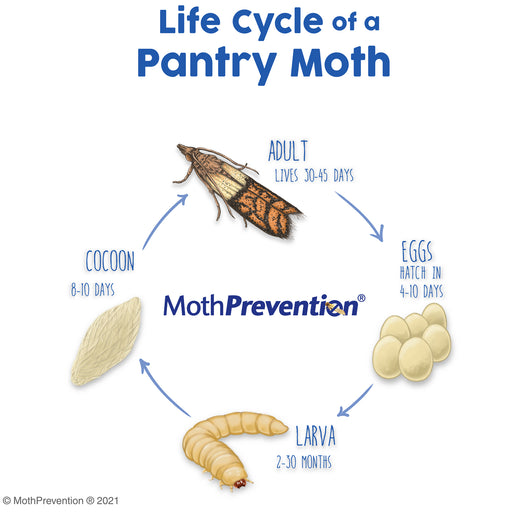
About Pantry Moths
The first thing to know when asking yourself “Why do I have moths in my cupboard?” is what type of moths you are actually dealing with. Most likely, Pantry Moths are to blame for an infestation. Indian Meal Moths, Almond Moths, Mediterranean Flour Moths, and Angoumois Grain Moths all lay eggs in pantries. These species in the Gelechiidae moth family, are also commonly referred to as "Rice Grain Moths".
How do Pantry Moths cause damage?
The eggs of the Pantry Moth hatch into larvae, which are responsible for doing the most damage to your belongings and dried goods. Adult Pantry Moths will mate and then lay their eggs in places that are rarely disturbed. Since oftentimes, cupboards are the home of items that have been sitting undisturbed for several months at a time, a Pantry Moth might deem an old bag of flour or box of muffin mix a suitable place to lay her eggs.
Female Pantry Moths also occasionally lay eggs on items being processed at food packaging facilities. Bird seed bags and bulk pet foods, for instance, sometimes harbor Pantry Moth Eggs that were laid during the packaging phase at facilities many hundreds of miles away.
Pantry Moth Larvae can:
• Destroy packaging
• Ruin food
• Lay eggs in the corners of containers
• Leave debris behind
• Cause certain food items to spoil
Where are Pantry Moths found?
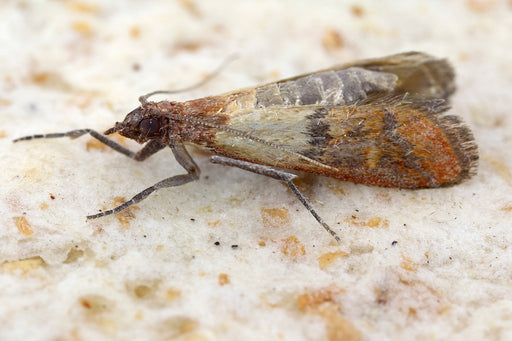
Pantry Moths can be found in just about every state in the United States and most of Europe. These moths may seemingly appear out of nowhere and begin plaguing your household. Any dark, quiet, or rarely disturbed place where dry goods are stored could become infested by Pantry Moths. This might include pantries, cupboards, drawers, closets, garages, cabinets, or even bins of food stored away on high shelves or under furniture!
What do Pantry Moth Larvae eat?
Pantry Moth larvae often consume raw processed grain, unprocessed flour, cornmeal, nuts, seeds, dog food, bird seed, you name it! Once the eggs hatch, larvae will basically begin consuming anything that they can chew through nearby.
Although the larvae of these moths feed almost exclusively on dry goods, they can also eat through an array of other non-edible materials including cardboard, paper, wicker, hemp, jute, and more!
Pantry Moth larvae commonly infest:
• Cornmeal
• Whole grains
• Rice
• Flour
• Dried beans
• Dry legumes
• Freeze-dried foods
• Brown sugar, white sugar, powdered sugar
• Raw grains
• Processed grains
• Granola
• Cereals
• Mixes
• Spices
• Nuts
• Birdseed
• Dried fruit
• Pet food
• And more!
How to tell if you have Pantry Moths in a cupboard?
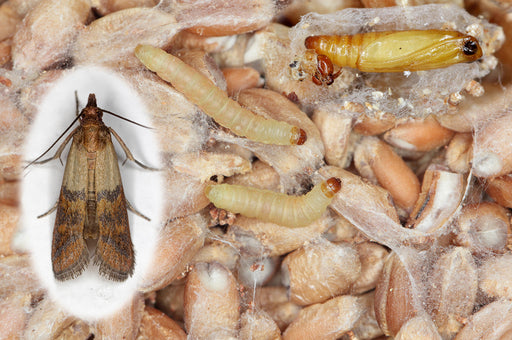
If you've seen moths flying out of your cabinets or near your cupboard spaces, there are a few things you can do to confirm whether you have a Pantry Moth infestation.
• First, check all of your powdery mixes, spices, unsealed foods or ones stored in paper or cardboard containers, and expired goods, for signs of moths. You can tell whether you are dealing with Pantry Moths by looking in powdery mixes for larvae or examining paper materials for damage.
• Keep an eye out for larval casings and little webs, as these may be from sticky Pantry Moth Eggs or cocoons. You can also look for signs of distress near the corners of packages, or near the seams of paper bags and cardboard boxes.
• As a rule, check your oldest bags of flour, boxed cake mixes, bulk grains, and other powdery dry materials first. The longer something has been sitting on a shelf in a cupboard, the more likely it is that moth larvae may have infested it. If you notice eggs or larvae inside of anything, you likely have Pantry Moths, and it’s time to start deep cleaning.
How Can I Get Rid of the Moths in My Cupboard?
If you have moths in your cupboards, getting rid of them right away is essential. After all, you don't want these insects ruining all of your food. Not to mention, the longer an infestation goes unchecked, the worse it will become and the further it can spread.
The most important thing to do when removing Pantry Moths from cupboard spaces is to clean thoroughly. Get some large trash bags and toss out anything that has become heavily infested. Then, start washing everything in your cupboard by hand, using hot soapy water.
After you've gotten rid of the bulk of an infestation, you can clean using your chosen kitchen cleaner. Remove all food items from your cupboards and drawers, and deep clean the shelves, walls, and crevices. Then, you can position Pantry Moth Traps to catch any adult male moths which will help break the breeding cycle and give you an indication of the size of your infestation.
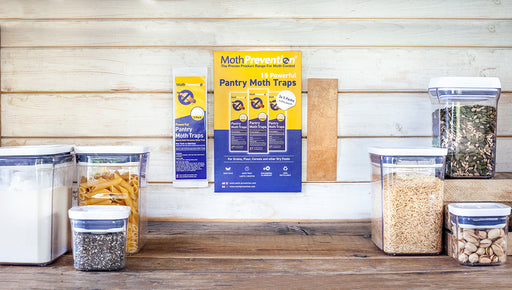
How To Get Rid Of Moths In Pantry Cupboard: Step by Step Instructions
Here are all of the steps to take to eliminate moths from cupboard spaces.
Step 1: Throw Away Infested Food
If you see signs of moth damage like little larvae crawling around in a box of pancake mix, toss it out. Although moth larvae are not harmful if accidentally consumed, they can cause certain items to spoil more quickly. Not to mention, if you have moths crawling around in a box of cake mix or bag of flour, there's a good chance that this commodity has already expired, anyway. As you throw spoiled items away, be sure to tie them off in airtight bags (large trash bags will do). That way, the infestation won't spread to other parts of your home during the cleaning process.
Step 2: Check Surrounding Areas for Moths
If there are drawers under your cupboard, totes of food stored nearby, or a pantry in the vicinity, check them all for signs of moths. Oftentimes, moth infestations spread quickly without anyone even knowing they have a moth problem.
Step 3: Remove, Wash, and Wipe All Articles in Your Cupboard
Now, remove all of the things from your cabinet or cupboard, and begin wiping everything down with hot soapy water. You should wipe off cans, containers, jars, lids, plastic bins, and anything else that may be harboring sticky moth eggs.
Step 4: Spray down with a natural residual Pantry Moth Spray.
If items can be washed in the dishwasher, you can use this method as well. Keep in mind that moth eggs are sticky and may be attached to the bottoms of items or in tight crevices, lids, containers, etc. So, be thorough as you clean. Wipe down all of the shelves in your cupboard as well as its insides, top, walls, and underside.
Step 5: Use Moth Traps and Proper Storage
Once your cupboard has been cleaned out, washed, dried, and sprayed down, you can begin putting your undamaged food items back. Be sure to implement proper food storage methods going forward to keep moths from being able to get into your goods again. Plastic or glass storage containers with airtight lids are very effective for keeping moths out. You should also set pheromone Moth Traps nearby to catch the adult male moths. By eliminating the adult males the breeding cycle is being disrupted.
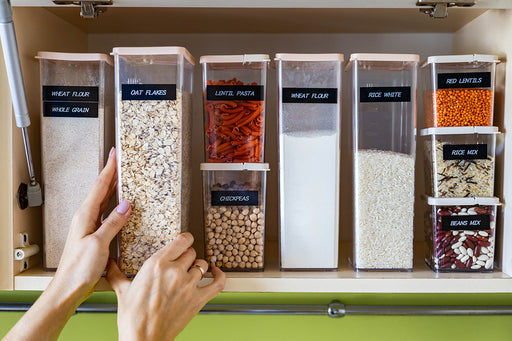
How To Kill Moths In Kitchen Cupboard: FAQs
Now that we've gone over how to get rid of moths in food cupboard storage areas, let's discuss some frequently asked questions on the topic. That way, you can proceed with confidence as you rid your home of moths.
Why are there moths in my cupboard?
If you notice a stray moth flying out of your cupboard, chances are, you have a bigger infestation to deal with. Moths like to frequent areas where abundant food sources are rarely disturbed by human activity. This could be the back of a cupboard where you are storing dry food items like cornmeal, flour, whole grains, granola, etc. Here, female Pantry Moths will lay eggs that hatch into ravenous larvae.
How do you get rid of moths in cupboards?
To get rid of Indian Meal Moths in a cupboard, throw away any infested items. If you don't want to throw something away, you can freeze it in an airtight bag for 72 hours to kill any hidden moth eggs or larvae. Then, thoroughly clean out the cupboard and wipe everything down with a natural residual Pantry Moth Spray. Finally, store food items in airtight containers and set pheromone Moth Traps to catch the adult male moths and help break the breeding cycle.
Why do I have moths in my cabinets?
Female Pantry Moths lay eggs in or near shelf-stable dry goods such as flour, cornmeal, cake mixes, sugar, and more. If you are storing items like this in cabinets and cupboards, a female moth may have chosen this as a suitable place to lay her eggs. The eggs hatch and then the larvae eat through nearby dry goods and grow into adults. Before you know it, you can have hundreds of moths in just one cabinet!
Are Pantry Moths harmful?
No, Pantry Moths are not harmful or poisonous to people or pets. However, the larvae of Pantry Moths can cause food to spoil more quickly.
Should I be worried about Pantry Moths?
Although Pantry Moths won't hurt you and aren't poisonous, they can cause your food items to spoil quickly. They can also cause damage to packages, decorations, and other nearby items. If you have signs of a Pantry Moth infestation, you should get rid of it right away before things worsen.
How to get rid of moths in cupboard crevices?
Moth eggs are sometimes hidden in cupboard cracks and crevices. To get rid of potential eggs in these hard-to-reach areas, spray the entire cupboard down with a natural residual moth killing spray. This should reach any concealed moth eggs and larvae. Only natural residual sprays should be used in kitchen and food areas.
How do I get rid of moths in cupboard spaces too high to reach?
Since female moths can fly, it's easy for them to lay their eggs in places up high and far away from regular human activity. If you are worried that moths have gotten into items stored on a high shelf or in a cabinet that's hard to reach, it might be time to bust out the ladder and go check for yourself. It's best to catch infestations like this as soon as possible to prevent them from spreading to other parts of your home.

What can I keep in my cupboard to keep Grain Moths away?
It's smart to set pheromone Pantry Moth Traps near or in cupboards and food areas which catch adult male Pantry Moths (also sometimes called Grain Moths) and take them out of the breeding cycle. These Traps are safe to use around kids, pets, and food. They give off powerful female moth pheromones to lure active male moths to their sticky surface.
About MothPrevention
MothPrevention® speak to customers every day about their clothes moth issues - clothes moths are a species that are ever increasing and that can cause significant damage to clothes, carpets and other home textiles.
To date, we’ve helped over 250,000 customers deal with their moth problems. We have developed professional grade solutions including proprietary pheromones and trap design engineered to the highest production standards.





